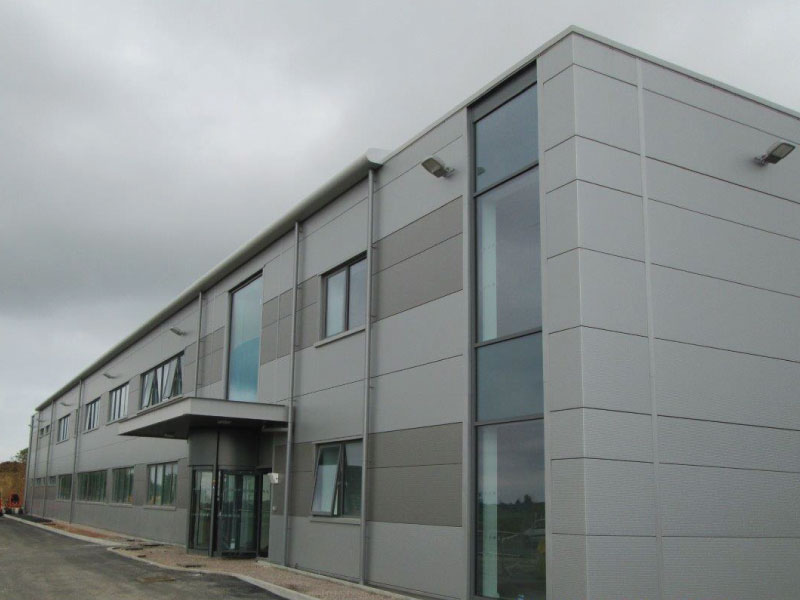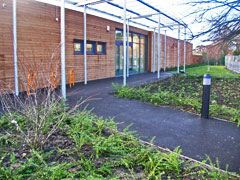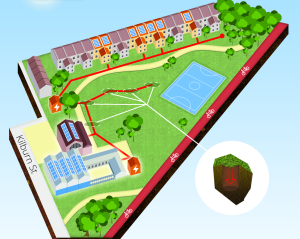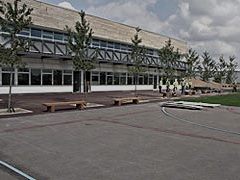GSHP Case Studies
GSHP case studies from ICAX provide a number of notable ground source installations. A number of interesting case studies are highlighted below. They show that ground source heat pumps can provide the best heating solution for buildings from small one bedroom bungalows to Regency mansions.
A GSHP can provide heating successfully to old buildings as well as new, to buildings in towns as well as buildings in the country, and to factories, hospitals and schools as well as to homes.

Cambridge Terrace, Regent's Park
Half of Cambridge Terrace has being refurbished as a single dwelling – the largest residence in London after Buckingham Palace.
A ground source energy system has been chosen for this Grade 1 listed Nash terrace to provide renewable heating and renewable cooling. The terrace will be cooled in summer by transferring heat down to a thermalbank in the ground. When heating is required in winter, heat will be recycled back to the building from the thermalbank to maintain a comfortable temperature in the building all year round.

Precision Engineering Factory, Hampshire
Ground source energy has been chosen for a new precision engineering factory in order to provide renewable heating and renewable cooling. Machining of components in exotic metals requires air temperatures to be controlled very precisely in order to meet the exacting tolerances required by aerospace clients. The new factory is cooled in summer by transferring surplus heat down to a borehole field in the ground. When heat is required in winter, heat is recycled back to the building from the borehole field to maintain a comfortable temperature in the building all year round. This is achieved by an automated system that balances the temperature in the building with the stable temperature natural to the ground by transferring heat from the ground in winter and storing surplus heat in the ground in summer: this achieves recycling of heat using precision engineering.

Merton Community Centre
The architects for the Merton Community Centre decided to go for the "elegant" solution in which one integrated system could provide both heating in summer and cooling in winter (as well as hot water all year round and the freedom not to have to organise, feed and manage a biomass boiler).

Solar Powered District Heating, Bristol
A Solar Powered District Heating Project in Bristol uses PV powered heat pumps to charge the ground with summer heat for easier extraction of heat in winter: Solar Powered District Heating .
The CHOICES consortium behind the project decarbonises heating by using green electricity in summer to charge an interseasonal heat store. Ground source heat pumps are used in winter to transfer heat into community buildings without burning fossil fuels. Grid balancing systems are employed to ensure that electricity is not demanded from the grid at times of peak use.
The consortium has created a district heating system based on solar energy and seasonal thermal energy storage which can be scaled up to serve additional buildings and be readily employed in other locations.

Suffolk One, Sixth Form College, Ipswich
Suffolk County Council has chosen Interseasonal Heat Transfer to achieve renewable heating for its new £65 million Suffolk One Sixth Form College, Ipswich, which was completed in September 2010. It incorporates the largest concrete solar thermal collector in the world with 14 kilometres of piping.
Suffolk One is the first Sixth Form College to benefit from Interseasonal Heat Transfer and demonstrates Suffolk County Council's commitment to renewable energy and education for sustainable development.
A wide range of energy efficient mechanical and electrical systems has being installed at Suffolk One with the aim of achieving a targeted BREAM rating of "very good". As well as Interseasonal Heat Transfer, rainwater harvesting, Windcatcher and Sunpipe systems are being employed to provide natural ventilation and light.

Merton's Acacia Intergenerational Centre IGC, Mitcham
Merton Council is using Interseasonal Heat Transfer as the most practical way to achieve more than 40% on site renewable energy for its new Acacia Intergenerational Centre which opened in February 2010. This the first building to benefit from Intrabuilding Heat Transfer as well as Interseasonal Heat Transfer.
The architects decided to go for the "elegant" solution in which one integrated system from ICAX could provide both heating in winter and cooling in summer (as well as hot water all year round and the freedom not to have to organise, feed and manage a biomass boiler).

HM Garth Prison, Lancashire
ICAX were approached by Mike Phillips of Home Office Custodial Property who had spotted a potential use for IHT technology in the prison sector. Following a careful feasibility study, it was decided to test it out in a new development at HM Garth Prison which was completed in September 2007.
ICAX completed the installation of its innovative sustainable technology at Garth Prison in Lancashire. This is potentially the first step for a new generation of on-site renewable prison houseblocks, heralding a significant advance in public sector sustainable thinking.
This was overseen by Interserve Engineering, with Mechanical and Electrical consultancy from the Leeds office of Hoare Lea.

Hiroshima
Misawa constructed a demonstration road in Hiroshima under licence from ICAX Ltd and confirmed that the Solar Road System worked well in Japan in clearing ice and snow from a trial road.
Misawa, who have extensive experience of using geothermal energy to clear ice and snow from roads in Japan, were interested to construct an IHT system under licence from ICAX Ltd to confirm that the Solar Road System worked well in Japan without going to the expensive of drilling boreholes down to the depths where geothermal energy can be reached.

Howe Dell School, Hatfield
Howe Dell School in Hatfield, Hertfordshire, was the first building in the world to benefit from Interseasonal Heat Transfer in an installation part funded by The Carbon Trust.
Howe Dell School, a 4,000 square metre building, has been developed with an ICAX IHT™ system that integrates an playground solar collector, a ThermalBank beneath the building as a hot store and a separate cold store. The scheme also uses the playground solar collector to pre-heat hot water for the school.
The IHT™ sustainable heating system complements a building design strategy for very low energy use to provide heating and cooling for the school.
The IHT™ installation has been commissioned by the Carbon Trust, as part of the Government’s drive for implementing renewable energy technology. The school is commissioned by Hertfordshire County Council as an exemplar Eco School using Renewable Energy.

Toddington demonstration for the Highways Agency
The Toddington Demonstration was the first Interseasonal Heat Transfer installation. This was completed for the Highways Agency to demonstrate that heat could be collected from roads in summer and stored in ThermalBanks until needed to keep the same road free from ice in winter. It also demonstrated the capacity to collect heat in summer for space heating in winter, and the use of IHT for providing cooling to buildings in summer. The demonstration was independently assessed by the Transport Research Laboratory who reported on the successful results of this two year test in April 2008 and verified the heat transfer computer modelling work previously carried out by ICAX.




